
Email marketing has a return on investment of 3600%, so it makes sense that this is a major part of your business strategy.
In order to see that return, you need to write email content that people are actually going to read.
So, needless to say, it is really important to learn how to write your emails. To help, we’ve put together 10 easy-to-implement tips to improve your email marketing content and increase your clicks.
Effortlessly export your Google Docs to WordPress with just 1-click.
Get Started Today
Your subject line could be the single most important element of your email — for obvious reasons. In fact, 47% of email recipients will open an email based solely on the subject line. And conversely, 69% of recipients will mark an email as spam based on the subject line alone.
Needless to say, if people don’t open your email, it doesn’t matter how strong your email content is, they’ll never get a chance to read it.
While there are several ways to write a great subject line, the best ones have a few things in common:
Let’s analyze a subject line test from AWeber, an email service provider. The purpose of this test was to see if a more direct subject line [25 easy (and free) marketing tools the experts use] would outperform a teaser subject line [What do coffee & these free marketing tools have in common].
The results were pretty overwhelming. The direct subject line had an open rate of 33.7% compared to the teaser subject line’s open rate of 31.8%. As a result of more people opening the emails, the direct version had a click rate of 2.5% vs 1.8% for the teaser alternative.

Your subject line did it’s job; it got your subscriber to open the email. Now it’s time to follow through with your content. Your email was opened because it triggered an emotion – a need to learn more.
Make sure your email content relates to your subject line. Delivering what you promised is the key to a successful email marketing campaign.
In this example, see how Canva’s subject line connects with the offer in their email.

Understanding the right way to structure your email is just as important as writing effective email content.
Why?
Because of the 3 second rule – that’s how long you have to convince your audience to take action in your email.
If you’re selling a single product or want to share a promotion, 3 seconds may be plenty of time.
Just look at this example from Eclectic Goods; it takes no time for you to get excited about the offer.

Source: ReallyGoodEmails
But what if you have more to share with your audience. The key is making your email scannable.
Use headlines to pull out the main benefits of a section. You can also use images to help visually tell your story. Don’t make your readers search for the important details of your email. Make them easy to find.
Check out this example from Exposure (this is only a portion of their long newsletter), they do a great job using images and headlines to clearly break out each section, making it easy for readers to skim the content.

Source: ReallyGoodEmails
If you’re not sure how to create an email newsletter that’s easy to scan, start with a pre-built template. Many email service providers offer pre-built, customizable email templates you can use with their newsletter creator. Just add your logo, copy, headlines, CTAs, and images.
Headers are used to grab the reader’s attention. Use this important real estate to sell them on the benefits.
For example, AWeber sent an email with content helping subscribers set up an abandoned cart email. Which of the following headlines do you think had a higher engagement rate?
Features: Learn How to Set Up Abandoned Cart Emails
Benefits: Get 20% More Sales with Abandoned Cart Emails
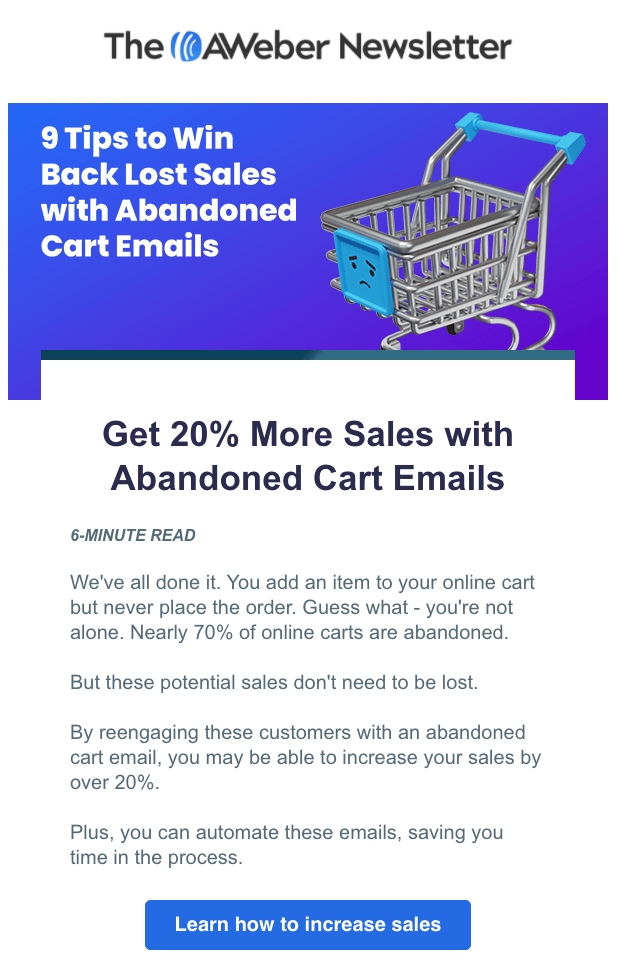
Source: AWeber
If you said “Get 20% More Sales with Abandoned Cart Emails” then you’d be right.
This headline does a fantastic job communicating what could be achieved with an abandoned cart strategy.
Your emails should sound as if you’re having a conversation with a friend or family member.
They shouldn’t sound like an advertisement.
Having a conversational email is the foundation for creating a relationship with your subscribers. You can consider adding your email signature block to your newsletter footer.
Here’s a perfect example from Outer. Their content is relatable to a reader who enjoys spending time outside. They don’t mention their product until halfway through the email.

Source: ReallyGoodEmails
No matter the reason for your email — promoting a webinar, providing education in a newsletter, selling a product or service, etc — always write about the benefits, not the features.
To do this, you need to identify the underlying end result the reader will achieve.
Trying to think of the difference? Features are what your product can do. Benefits are the results your customer can get out of your product.
Ultimaker does a great job of focusing on the benefits. They’ve identified “speed” as a customer pain point when 3D printing software. They’ve addressed this front and center with their email, referring to the product benefit.
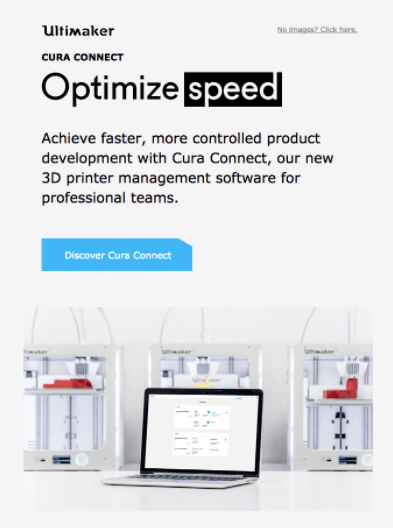
Source: ReallyGoodEmails
Now suppose Ultimaker simply switched the order of their first sentence to focus on the product and not the feature. So instead of –
“Achieve fast, more controlled product development with Cura Connect, our new 3D printer management software for professional teams”, it read:
“Our new 3D printer management software for professional teams. Get Cura Connect and achieve fast, more controlled product development”
Now the email focus is more on the company, then the consumer benefits.
A personalized email can increase engagement rates by 6x.
But you won’t get those increased rates simply by adding someone’s first name to the subject line. If writing good email content was that easy, everyone would be an expert.
To craft a truly personalized email you will need to look at your data to get a better understanding of your customers. Knowing your customers’ personalities is the first step in creating the types of content they might actually want to read. Another key factor in personalization is ensuring that your messaging resonates from the very first touchpoint is your subject line. It’s the gateway to your email, and small changes in wording, tone, or structure can have a major impact on open rates. That’s why running a subject line test is crucial for understanding what grabs attention and drives engagement.
Look at previous content they’ve engaged with or products/services they’ve purchased. You can start using tags to identify groups of customers. Once you have these segments of subscribers defined, you can start writing personalized content for these different audience niches.
Netflix is one of the best at personalizing their emails. They know based on other shows I watch, that Iron Fist is highly likely to interest me. And they were right (not for the first time). This email is so personalized to my interests, that no copy was really needed to sell me on watching this show.
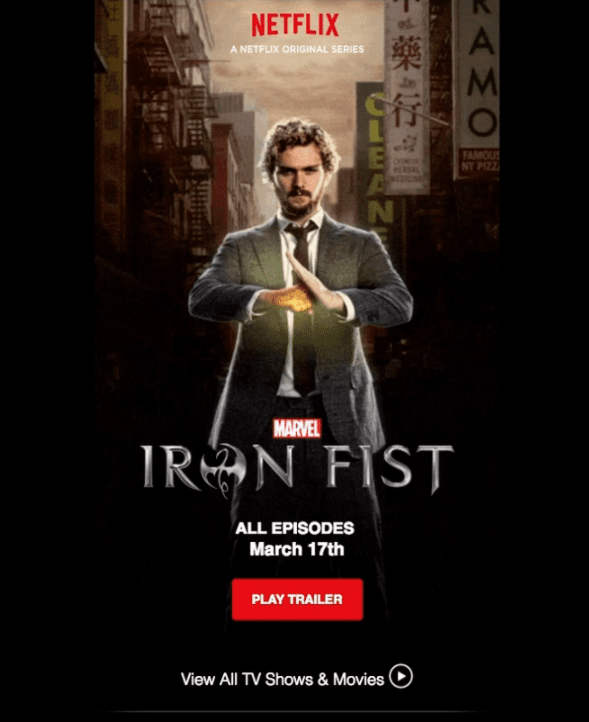
Here’s another example from Uniqlo. They’re using the current weather conditions of their customer’s homes to sell relevant products.

Writing in the second person puts the reader into your story, or in this case email content. This is especially important if you’re selling a product.
By writing in this perspective, you’re making it easier for the reader to envision themselves enjoying the benefits of your product. This increases the likelihood of readers clicking on your emails and potentially converting once they get to your website.
Here are two perfect examples:
Not once in this email from Haus did they mention the reader. The email talks about their “go-to” and what they do on their last long weekend. Remember, it’s not about YOU, it’s about YOUR READERS. Understand their needs, then make them part of the story.
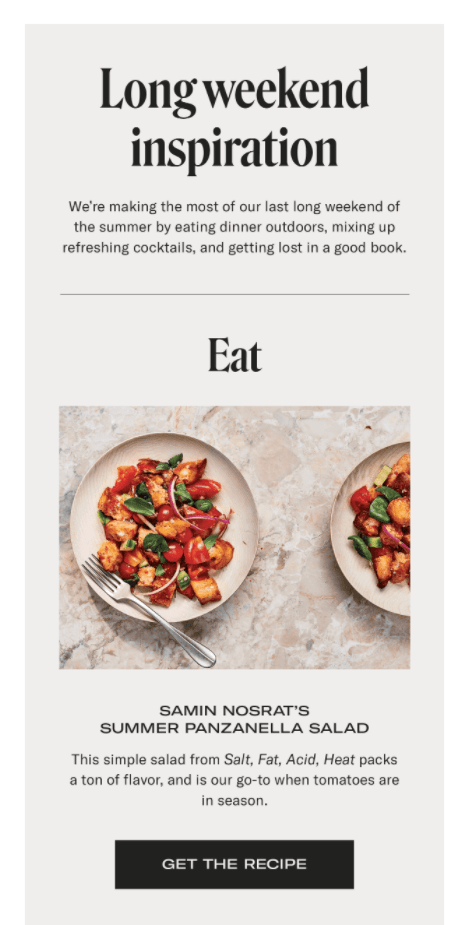
Source: ReallyGoodEmails
Conversely, Raymour & Flanigan does a great job of putting the reader into their story.
They could have easily talked about their mattresses, but instead, put their customer’s needs first.
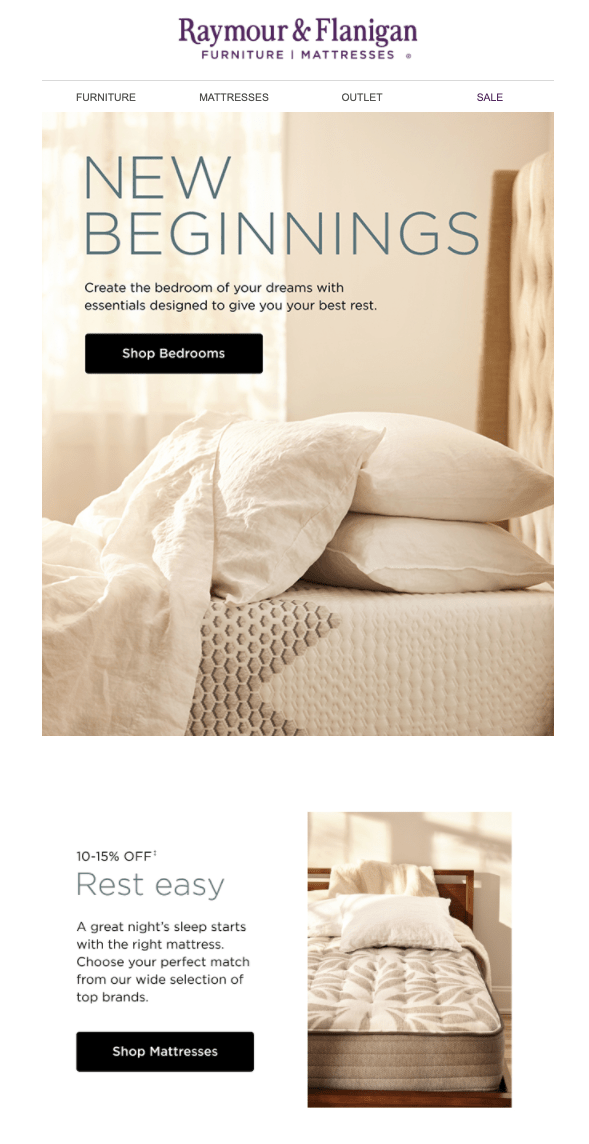
Keep your content simple. Avoid using industry jargon as much as possible. Not all of your customers or prospects will understand your business or industry on an advanced level, so try to break things down in layman’s terms.
But if you absolutely need to use industry jargon, be sure to define what each term means either directly in your post, or by linking to another website or blog post that offers a clear explanation.
Before brainstorming or writing content, always ask yourself what the reader will get out of it. Why should someone read, watch, or listen to what you have to say?
By making it worthwhile for them (such as solving a problem they have or offering helpful advice), they’ll learn that what you have to say is valuable and will come back for more content.
Now that you went through our tips to write email content that will increase your clicks, you’ll need to monitor your email marketing metrics, especially your open and click-through rates. These metrics will help you measure the effectiveness of your campaign.
Open rate – this KPI is directly impacted by your subject line. A strong, relevant subject line will lead to higher open rates.
Click-through rate – several factors could impact your click-through rate, including your email copy, the images, your CTA’s, and the overall layout of your email.
Now it’s time to take what you’ve learned and apply it to your next email.